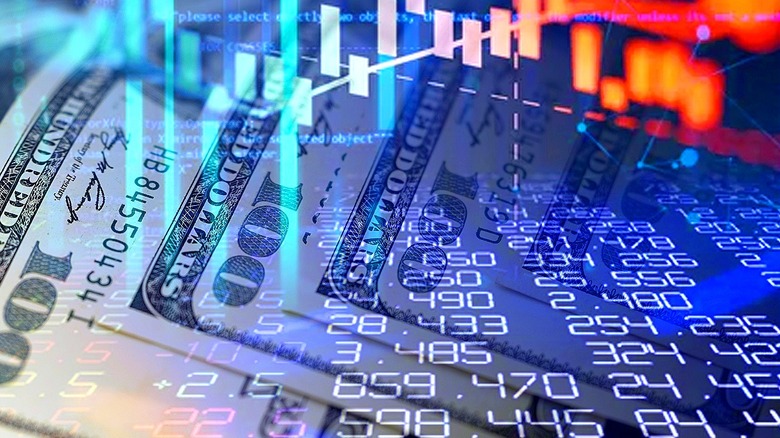What Happens During A Market Correction (And Can You Get Ahead Of One)?
We may receive a commission on purchases made from links.
Investors the world over dread the words "market correction." They're even more allergic to the idea of a full-blown bear market. Plenty of investors are well-versed in the procedures of trading in a growing market or even one that's performing at a relatively flat trend. But a market correction is a different beast, entirely. Moreover, it requires some preparation, both mentally and financially.
Some of the most influential investors of our time are clear on what to do in a market correction or bear-trading period (people like Warren Buffett, who offer plenty of tips and tricks that average investors can emulate). Even so, investors, especially those who are newer to the market, often find themselves flailing when the tide begins to go out.
In a conversation with Lawrence Sprung, CFP, founder of Mitlin Financial, and author of "Financial Planning Made Personal," we discussed the ins and outs of a market correction. Sprung talked us through some of the potential indicators that a correction might be brewing and discussed the calm demeanor necessary to weather the storm. Specifically, Sprung noted the importance of staying in control and highlighted just how frequently market corrections take place.
Signs of a market correction
It's important to start by mentioning just how natural a market correction really is. "The definition of a market correction is simply a 10% (but not greater than 20%) decline from the peak," Lawrence Sprung explained. "We typically experience one market correction per year, which makes it a completely healthy event," he added.
Corrections can take place at any time, and exist on a sort of rolling basis. At any given time, stock prices hit new peaks or trade at some position in relation to a recent highwater mark. Everyone likes seeing their share price grow, but stocks can't continue to trade at increasingly higher values indefinitely. This is where a market correction comes into play.
Sprung said "one of the biggest signs is a change in sentiment around investing, which can have a direct impact on returns and then exhibit the signs of a correction." Basically, when investors start to get itchy feet over the ongoing performance of the market, momentum in the near term sometimes (but certainly not always) starts to follow these sentiments. No investor holds a crystal ball, but when enough traders start to show off a worried demeanor, the rest of the market takes notice and begins to slow down the pace of trading, creating the conditions that can ultimately turn into a correction. (Read about the best and worst stock predictions in U.S. history.)
Can you anticipate the market?
Lawrence Sprung advises against trying to actively anticipate and react to the market. "Wouldn't it be great to have a tool that would signal (with 100% certainty) that a market correction is on the way?" he mused. "It would be very helpful. Unfortunately, such a tool does not exist." While correction behavior sometimes fits known patterns, the reality is that plenty of economic stimuli can create corrections but don't trigger a 10% fall in value, while novel triggers can launch a market-correction period without prior warning, at times.
Said Sprung, "There are certain market events or technical chart moves that can help indicate a correction is on the way, but we would not know until we saw the markets hit that 10% decline. Increased volatility in the markets could be an indication that a correction is coming or even a simple thing like the advance/decline line showing less participation from stocks in the market's appreciation."
Yet, any number of factors can coalesce to generate either upward or downward pressure on stocks. Moreover, this pressure can last for a short period of trading or an elongated timeline. Corrections can therefore last for hours or for days, or ultimately exist over prolonged periods. Near-correction conditions (either not-quites or total crashes on opposite ends of the spectrum) can also form without officially crossing into this territory, too. At the end of the day, because they are just so common in the modern stock market, a correction shouldn't trigger a major change in the way you approach your long-term strategy. (Check out how market corrections and market crashes differ.)
Weathering the storm for the long haul
Lawrence Sprung holds the same values as virtually every other pro trader. Rather than allowing a sudden decline in pricing to rattle you, stay the course and consider doubling down on your investment positions. "Investors," he said, "would be better served creating a diversified portfolio that can weather a market correction rather than trying to time when and if it will take place." In reality, there's little point in trying to anticipate and time a market correction. The successful execution of this strategy would see you selling off assets just before a severe dip in value across the market, only to turn around and buy up assets again at a reduced rate.
There is value in researching market trends and individual stock price charts to sell when you expect an asset has become overvalued, but to time the market as a whole is, in reality, a fool's errand. Pros can't beat the market consistently, with an increasing number underperforming as the study period lengthens. Case in point, according to S&P Dow Jones Indices data, 79.8% of large-cap fund managers underperform over a three-year period, while 93.58% of them underperform the market over 20 years' time. Considering this, retail investors have little hope when it comes to besting the market's ups and downs.
Instead, stay true to your fundamentals, hold rather than sell when a correction does come your way, and try to buy more whenever possible. With the market discounted by at least 10% during a correction, there's more than a few great value deals out there. (Learn if there's a best day of the week to buy stock.)



